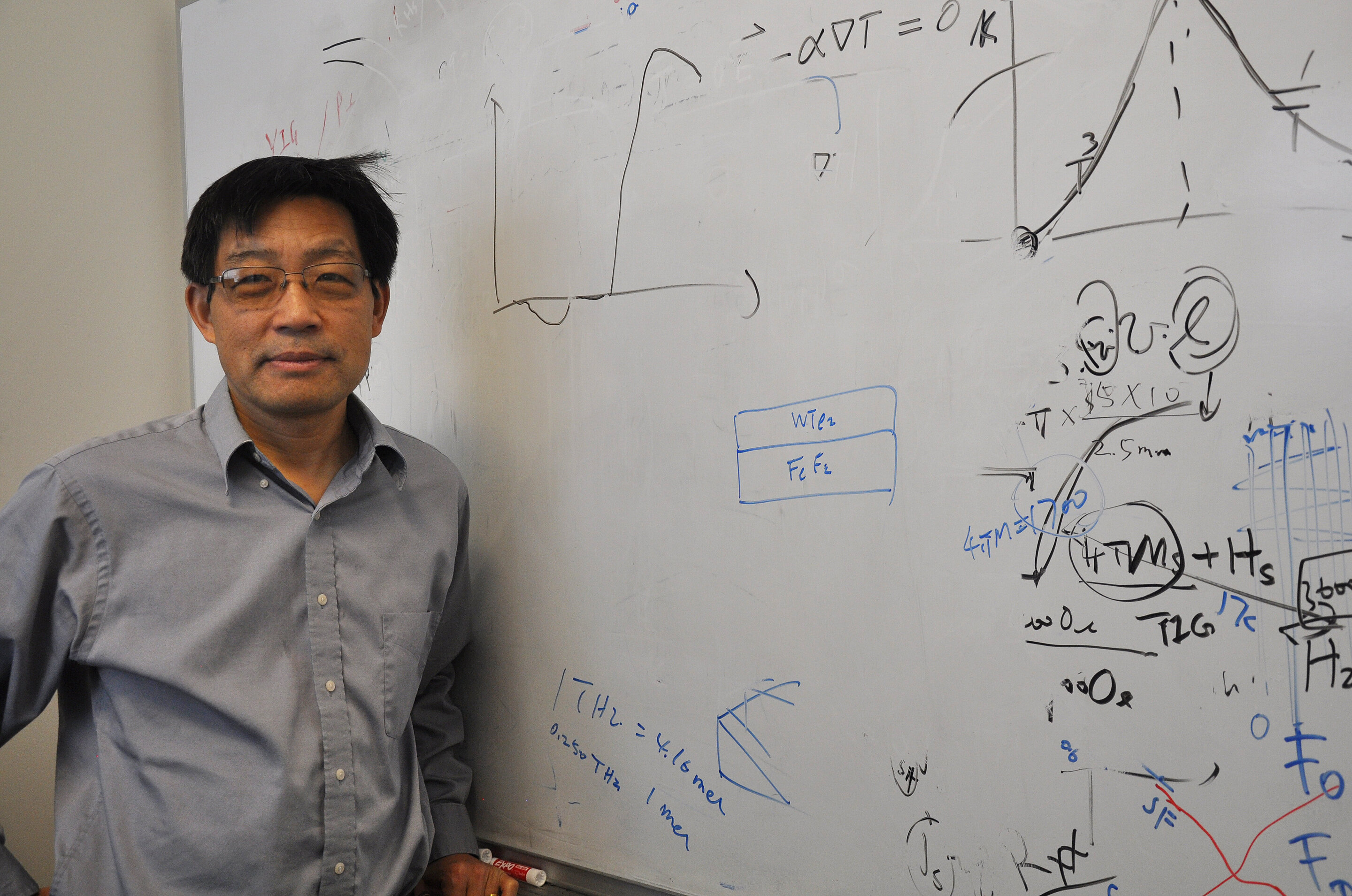博文
检测超高频磁共振可能会彻底改变电子设备
|||
检测超高频磁共振可能会彻底改变电子设备
诸平
据美国加州大学-河滨分校(University of California - Riverside)2020年1月27日提供的消息,该大学物理与天文学系Jing Shi教授(见图1)领导的一个研究小组发现了太赫兹(Terahertz)电磁波的电检测方法,这种方法很难检测。这一发现可能有助于使微芯片上的检测设备小型化,并提其高灵敏度。太赫兹是电磁波频率的单位:1兆赫兹(gigahertz, GHz)等于109赫兹(1 GHz=109 Hz);1太赫兹等于1000兆赫兹(1 THz=1012 Hz)。频率越高,信息传输越快。例如,手机的工作频率为几GHz。

Fig. 1 Jing Shi is a professor in the Department of Physics and Astronomy at UC Riverside. Credit: I. Pittalwala, UC Riverside.
相关研究结果于2020年1月27日在《自然》(Nature)杂志上发表——Junxue Li, C. Blake Wilson, Ran Cheng, Mark Lohmann, Marzieh Kavand, Wei Yuan, Mohammed Aldosary, Nikolay Agladze, Peng Wei, Mark S. Sherwin, Jing Shi. Spin current from sub-terahertz-generated antiferromagnetic magnons. Nature, Published: 27 January 2020, DOI: 10.1038/s41586-020-1950-4 , https://nature.com/articles/s41586-020-1950-4.这一发现是基于反铁磁材料中的磁共振现象。这种材料也称为反铁磁体(antiferromagnet),为超快和基于自旋的纳米级器件应用提供了独特的优势。
由加利福尼亚大学河滨分校的物理学家Jing Shi领导的研究小组,在反铁磁体中产生了自旋电子学(spintronics)中的重要物理量自旋流(spin current),并能够对其进行电检测。为了实现这一壮举,他们使用了太赫兹辐射(terahertz radiation)来激发色度不足的磁共振,以方便对其进行检测。
在诸如条形磁体的铁磁体中,电子自旋(electron spins)指向相同的方向,即向上或向下,从而为材料提供了集中的强度。在反铁磁体中,原子排列使得电子自旋相互抵消,其中自旋的一半指向另一半的相反方向,即向上或向下。
电子具有固定的自旋角动量(spin angular momentum),可以绕垂直轴自旋陀螺进动。当电子的进动频率与由作用在电子上的外源产生的电磁波的频率匹配时,就会发生磁共振,并以大大增强的信号形式出现,易于检测。
为了产生这种磁共振,来自加州大学河滨分校(UC Riverside)和加州大学圣塔芭芭拉分校(UC Santa Barbara)的物理学家团队,使用了圣塔芭芭拉分校的太赫兹科学技术研究所(Institute for Terahertz Science and Technology's Terahertz Facilities)太赫兹设施产生的0.24太赫兹(0.24 THz)辐射,该辐射与氧化铬(chromia,Cr2O3)中电子的进动频率非常匹配,发生磁共振,随之导致自旋流,研究人员将其转换为DC电压。
物理学和天文学系的教授Jing Shi说:“我们能够证明反铁磁共振可以产生电压,这就是实验上前所未有自旋电子效应(spintronic effect)。”
Jing Shi教授是美国加州大学河滨分校,由美国能源部资助的能源前沿能源研究中心(Department of Energy-funded Energy Frontier Research Center)的纳米电子系统自旋和热系(Spins and Heat in Nanoscale Electronic Systems, or SHINES)项目的主持人。他解释说,次太赫兹辐射(subterahertz radiation)和太赫兹辐射(terahertz radiation)是检测的挑战。当前的通信技术使用吉赫微波(gigahertz microwaves)。
“对于频率更高的带宽,趋势是朝太赫兹(THz)微波发展。”Jing Shi说:“太赫兹微波的产生并不困难,但是它们的检测却非常困难。我们的工作现在为芯片上太赫兹检测提供了一条新途径。”
尽管反铁磁体在静态上并不有趣,但它们在动态上是很有趣的。反铁磁体中的电子自旋进动比铁磁体中的快得多,因此其频率比铁磁体的频率高出两个数量级,从而可以更快地传输信息。Jing Shi说:“与铁磁体相比,反铁磁体中的自旋动力学(Spin dynamics)发生的时间要短得多,这为潜在的超快器件应用提供了诱人的优势。”
反铁磁体的存在比铁磁体更普遍,并且含量更高。许多铁磁体,例如铁和钴,在被氧化时会变成反铁磁性,许多反铁磁体都是能量消耗低的良好绝缘体。Jing Shi的实验室在制造铁磁和反铁磁绝缘体方面具有专长。他们曾经开发出了一种由氧化铬(Cr2O3,一种反铁磁绝缘体)组成的双层结构,在其顶部具有一层金属,用作检测来自氧化铬的信号的检测器。Jing Shi解释说,氧化铬中的电子保留在局部,穿过界面的是在电子的进动自旋中编码的信息。他说:“界面至关重要。” “自旋灵敏度也是如此。”
研究人员通过专注于铂和钽作为金属探测器来解决自旋灵敏度问题。如果来自氧化铬的信号来源于自旋,则铂和钽会以相反的极性记录信号。但是,如果信号是由加热引起的,则两种金属都会以相同的极性记录信号。
“这是反铁磁材料中第一个成功生成和检测纯自旋流的方法,这在自旋电子学中是一个热门话题,”Jing Shi说,“反铁磁自旋电子学(Antiferromagnetic spintronics)是SHINES项目的主要重点。”更多信息请注意浏览原文或者相关报道,诸如转到的磁学:科学家发现了成像自旋的新方法(Magnetics with a twist: Scientists find new way to image spins)
Abstract
Spin dynamics in antiferromagnets has much shorter timescales than in ferromagnets, offering attractive properties for potential applications in ultrafast devices1,2,3. However, spin-current generation via antiferromagnetic resonance and simultaneous electrical detection by the inverse spin Hall effect in heavy metals have not yet been explicitly demonstrated4,5,6. Here we report sub-terahertz spin pumping in heterostructures of a uniaxial antiferromagnetic Cr2O3 crystal and a heavy metal (Pt or Ta in its β phase). At 0.240 terahertz, the antiferromagnetic resonance in Cr2O3 occurs at about 2.7 tesla, which excites only right-handed magnons. In the spin-canting state, another resonance occurs at 10.5 tesla from the precession of induced magnetic moments. Both resonances generate pure spin currents in the heterostructures, which are detected by the heavy metal as peaks or dips in the open-circuit voltage. The pure-spin-current nature of the electrically detected signals is unambiguously confirmed by the reversal of the voltage polarity observed under two conditions: when switching the detector metal from Pt to Ta, reversing the sign of the spin Hall angle7,8,9, and when flipping the magnetic-field direction, reversing the magnon chirality4,5. The temperature dependence of the electrical signals at both resonances suggests that the spin current contains both coherent and incoherent magnon contributions, which is further confirmed by measurements of the spin Seebeck effect and is well described by a phenomenological theory. These findings reveal the unique characteristics of magnon excitations in antiferromagnets and their distinctive roles in spin–charge conversion in the high-frequency regime.
https://wap.sciencenet.cn/blog-212210-1216077.html
上一篇:Science: 新发现动摇了我们对基因表达的理解
下一篇:如何应对氯化饮用水存在的安全隐患?